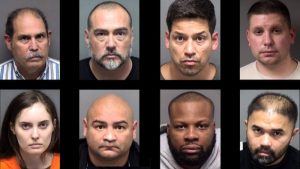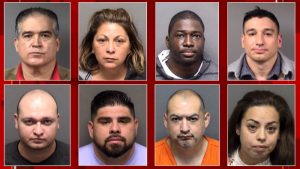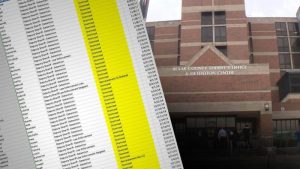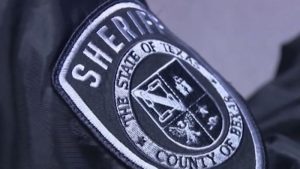
Bexar County law enforcement officer arrests rose 20 percent in 2021 – KSAT
A combined 25 peace officers from SAPD, BCSO charged in 2021; up 20% from 2020 [from KSAT]

A combined 25 peace officers from SAPD, BCSO charged in 2021; up 20% from 2020 [from KSAT]

Fifteen deputies, ranging from newly hired temporary jailers to longtime veterans of the agency, ended up on the wrong aside of the law this year,

Bexar County Sheriff Javier Salazar fired more than 100 deputies during his first term in office and only a handful were able to win back

The Deputy Sheriff’s Association of Bexar County has overwhelmingly voted in favor of a new five-year collective bargaining agreement with Bexar County, according to a

A major change was announced Monday for the Bexar County Sheriff’s Office as part of the collective bargaining agreement — no more arbitration, and the
This Officer Suspension Dashboard has been created as an effort to offer further transparency to the public about the conduct of Bexar County Sheriff’s Office (BCSO) Deputies. We have collected suspension documents from 2019-2023, and will be updating our data frequently. It should be noted that we have inputted all the data we have received but there may be some suspensions or firings not represented. At this time, we have not received many detailed documents explaining the suspensions or firings represented on this dashboard. These incidents are represented in the ‘Unknown’ incident category. Additionally, this dashboard does not include suspensions issued for purely attendance-based violations or probationary deputy firings. We have maintained the incident categories used in the SAPD dashboard for comparative purposes. BCSO uses a different incident type language than what is represented in this dashboard.
This dashboard will serve as a “watchdog” for deputies that violate laws and departmental policies. Not only will it alert the community but will be a tool to hold deputies accountable and be a deterrent for bad behavior and assist smaller law enforcement agencies in making good hiring choices, to reduce the issue of “wandering officers.” Finally, any trends from this data will better inform training practices for law enforcement agencies on de-escalation, cultural sensitivity, mental health training, hiring practices, and more.
You can search this dashboard by officer name, incident type or disciplinary outcomes. You can also filter by jail deputies versus patrol deputies in the bottom lefthand corner under the officer name dropdown menu.
It is our full intent to add other local departments, such as the Bexar County Constables. We were unable to include them in this version of the dashboard because many of their documents are not digitized. We will work to include data from other Texas police departments such as Austin Police Department, El Paso Police Department, and other Texas sheriff’s departments.
This dashboard was a project funded by the Catalyst Grant offered by the Urban Institute and Microsoft Justice Reform Initiative. We would like to thank the Microsoft team, Urban Institute, and our data leads Brittany Sharp and James Dykman for working tireless hours to make this project a reality!
BCSO data has been received through Open Records Requests (ORR) from the Bexar County Sheriff’s Office Public Information Act Request Center. Unlike SAPD the Sheriff’s Office does not publish suspension or arbitration documents on their website.
The most common officer misconduct were Responsibility to Serve the Public (this is a wide ranging category that includes violations like using profane and derogatory language, being rude to civilians, and general bad behavior), Responsibility to Know Laws and Procedures, Creating Unsafe Jail Conditions (this is a wide ranging category that includes violations like use of force within the jail, not taking people to medical treatment and a deputy action or inaction that leads to an assault or death of an incarcerated person).
It should be noted that the two individuals with the greatest number of suspensions, Vanessa McRoberts (5 suspensions) and Thomas Gilliland (6 suspensions), are both Detention Sergeants with supervisory duties.


An officer is placed on unpaid leave for a given period of time.
An officer has been fired.
The officer agrees to the suspension given to them. They can either agree to the full term of the suspension or sometimes agree to reduce the suspension, but not appeal it.
Use of an outside lawyer (known as an arbitrator) to settle a dispute, such as appealing a firing or suspension. Arbitrators will review an entire disciplinary case and make a decision to sustain, reduce, or reverse an officer’s suspension/indefinite suspension.
The BCSO disciplinary process no longer includes arbitration as of the newest Collective Bargaining Agreement ratified by Commissioner’s Court in February of 2022.
Types of incidents that did not fit into other categories and were not common enough to have their own category. These types of incidents include conducting off duty traffic stops, not completing required training, excessive absences leading to a firing, and various administrative violations.
While sifting through collected data, we noticed that detailed documents were not provided to us by BCSO for all suspensions or firings. We are requesting these documents but are missing incident summaries and incident types for these suspensions.
Do you have a suggestion for how to improve the Officer Suspension Dashboard? Let us know! Provide your input below. We are continuously working to make the dashboard more informative for our community.